MAINLAND SPAIN
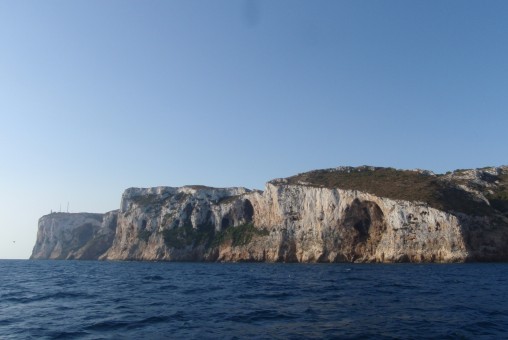
Dramatic Costa Blanca
We went to Denia for two reasons. First, it was the closest marina. Second, we were in search of a cruising guide for the mainland coast, and a chandlery there e-mailed us that they had it.
We called Marina de Denia, and they had a berth available. It was quite narrow, and we were concerned about getting in to it with 15 knots of wind blowing across our bow. It was not our prettiest effort, but we made it.
The marina was just another marina. But we went to town and found the cruising guide that we wanted, so we felt safer heading down the coast. We walked around town for a few hours, and it was not particularly interesting. We found a restaurant selling Turkish kebabs, and we ate well.
We had a lot of dirty laundry, and the marina had a coin-operated washing machine. We decided to stay a second night so that we could wash our decks (covered in sand) and do laundry. After paying for our second night, we learned that the washer was not working. So we spent the entire day washing decks and doing laundry by hand. And we planned our trip to Gibralter.
We decided that we would leave the next morning and go as far as possible on a day sail. We would stop for the night, then we would be able to make it to Gibralter after two nights out.
61 miles in 10 hours 40 minutes
We actually sailed much of this trip. We had a nice beam reach for a few hours.
The big event of this day was that we crossed the prime meridian going from the eastern to western hemisphere. We have crossed the equator and date line a few times, and now we have crossed the prime meridian.
We spent the night in a rolly anchorage just southwest of Punto de Esparto. But it calmed a bit a few hours after dark when most of the boats stopped creating wakes. We left the next morning planning to sail non-stop to Gibralter.
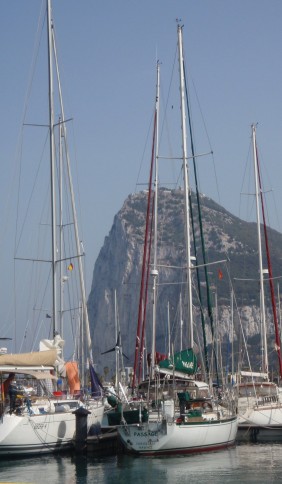
Passage in La Linea near Gibraltar
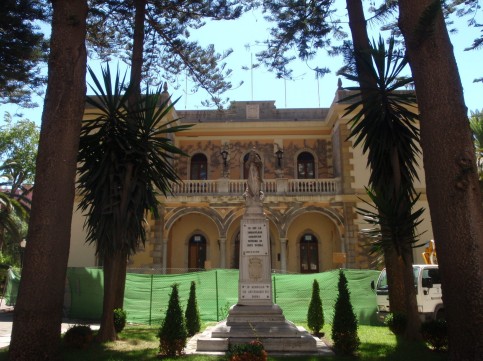
Beautiful Spanish architecture in La Linea
We spent two nights out and arrived in Gibralter mid-day of our third day – on Bud’s 66th birthday August 19. Most of the trip was uneventful.
On our first day, we had a nice sail for a while, but conditions deteriorated. The wind increased to 27 knots, the seas built, and the barometer dropped by 4 points rather quickly. We knew that a shallow low was nearby, and we worried that it might deepen, so we headed in towards shore rather than following the rhumbline. Closer in, the winds varied from 7 to 24 knots, and they came from all directions. It was a bit sloppy and uncomfortable, but we decided to carry on closer to shore in case conditions deteriorated further. They did not.
On our second day we rounded Cabo de Gata just before dawn in calm winds. We were traveling close to shore trying to avoid the strong east current common in this area. We had heavy fog that took most of the day to burn off.
On our third day we again had heavy fog in the morning. We were approaching Gibralter and maneuvering our way through a lot of anchored and anchoring ships. Thank goodness for our radar!
The marinas in Gibralter are known for being unfriendly to cruising boats, and they almost always send them away. We went to Alcaidesa Marina less than 100 yards from the border with Gibralter. Alcaidesa Marina is in the town of La Linea, Spain.
The name of the town is actually La Linea de la Concepcion, but it is commonly referred to as La Linea. It is in the province of Cadiz in Andalusia. It is on the border with Gibralter, and it has a mutually dependent relationship with its neighbor. Many residents of La Linea work in Gibralter, and Gibralter relies on La Linea for much of its fresh food. The population of La Linea is approximately 62,000.
We really like La Linea. It is the first place we have been in Spain where we feel like we are seeing Spanish life. We have found our favorite tapas bar, and not a word or English is spoken. We stop for ice cream on the walk home, and we are the only ‘tourists’ to be seen. We have shopped the local markets, and we have found a good selection of goods. La Linea is a thriving little town. We walk across the border to Gibralter only for shopping that we cannot do locally, and we are quick to return to the quiet of La Linea.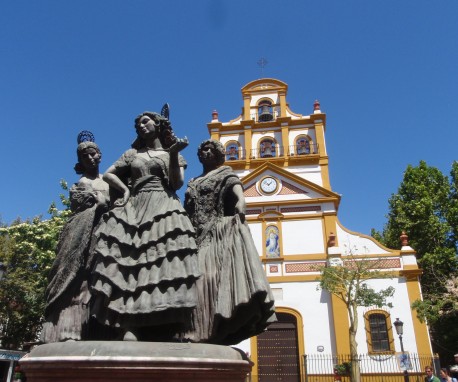
La Linea town square
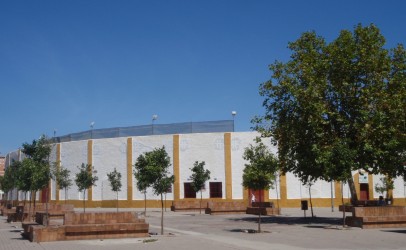
Bullring in La Linea
We have become interested in tapas in La Linea, and we have learned a bit about them – especially the local version. The most interesting is jamon ibericho de bellota. This is paperthin sliced ham from the patanegra (blackfoot) pig that forages on acorns as it doubles it weight from about 200 pounds to 400 pounds. The acorns impart an unusual sweet flavor to the meat. Although we do not normally eat pork at all, we have eaten a few products from this pig, and they are good.
We have also enjoyed the beer. We both really like beer, but Nita quit drinking a few years ago, and she still misses beer. Spain has numerous non-alcoholic beers that actually taste decent. They are not ‘good’ beer as compared to well-crafted beers, but they taste like beer and they are definitely drinkable (Cruzcampo Sin is our favorite). They are served in most restaurants, and Nita can now have a glass of beer with tapas. We have also loaded a few on board. What a treat!
We both like horses. As a child, Nita was particularly interested in the Andalusian and Percheron breeds (these two have little in common other than four legs and a tail). This seemed a good opportunity to see the Andalusian horse – we are, after all, in Andalusia. So on September 8, we attended a show called Pasion y Duende del Caballo Andaluz (Passion and Spirit of the Andalusian Horse) held in the bullring.
The horses were beautiful, and the setting was nice. There was live flamenco music including two dancers – one female and one male. The horses performed their fancy footwork, they did lots of jumps, and they even ‘danced’ with the flamenco dancers. Neither of us are familiar with dressage (we are both ‘western’ riders), so we enjoyed watching the various gaits of the horses, but we had different overall opinions of most of the show. Bud enjoyed the display of training and skill. Nita thought the horses were made to perform like circus animals and would prefer to see them doing what horses normally do. But we both enjoyed seeing these beautiful horses.
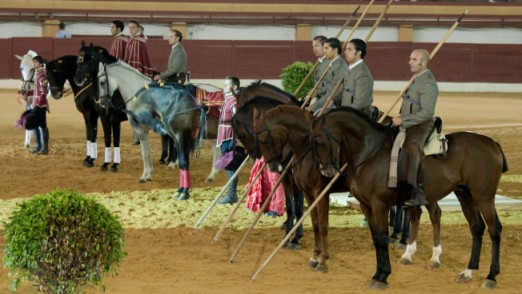
Beautiful Andalusian Horses
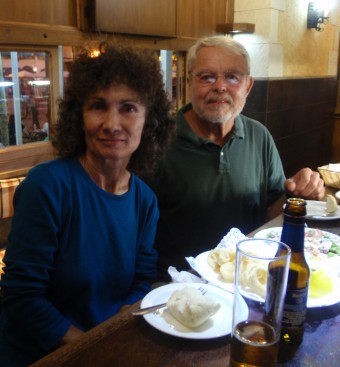
At our favorite tapa bar
We had been having some minor problems with our autopilot, and we decided to have it serviced while here. We met someone in whom we had confidence to do a good job, and we thought it would be prudent to do this before heading off on our long upcoming passages. So we planned to extend our stay in La Linea to about two weeks. What a mistake!
We gave the autopilot to Rob Thorne of Thorne Mechanical. We got it back 19 days later with absolutely nothing serviced, and it cost us hundreds of euros just to get it back. This was a very bad experience, and we would strongly discourage all from doing any business with this person.
Meanwhile we had missed two weather windows while waiting for our autopilot. Hurricane Nadine had formed in the central Atlantic, and she started heading east rather than west. The usual Azores high produces calm seas and northerly winds just right for traveling south to Madeira and/or the Canaries. However, Nadine displaced the high, and she created southerly winds and very big seas. So we sat, watched, and waited. And waited. Nadine became the fourth longest-lived Atlantic hurricane on record. When we saw that we could not get out for about a week ahead, we took advantage of the time and made a trip inland to Granada – a fascinating ancient city..
We finally accepted that we were not going to get the weather we needed to go to Madeira, and we waited only a short time longer to get the weather to leave for the Canary Islands. We looked forward to seeing another part of Spain.
Within Spain, you can return to the Balearic Islands, sail from the mainland to the Canary Islands, or jump ahead to the Canary Islands. Or you can walk across the border with us to Gibraltar.